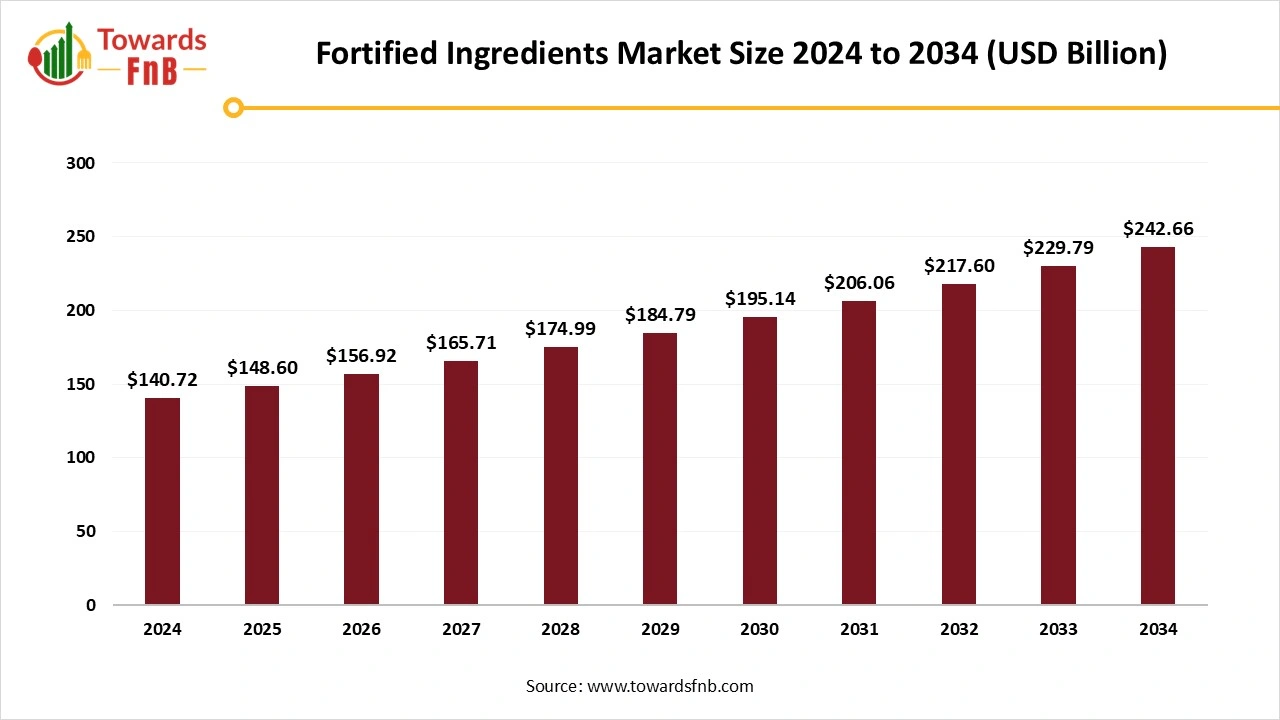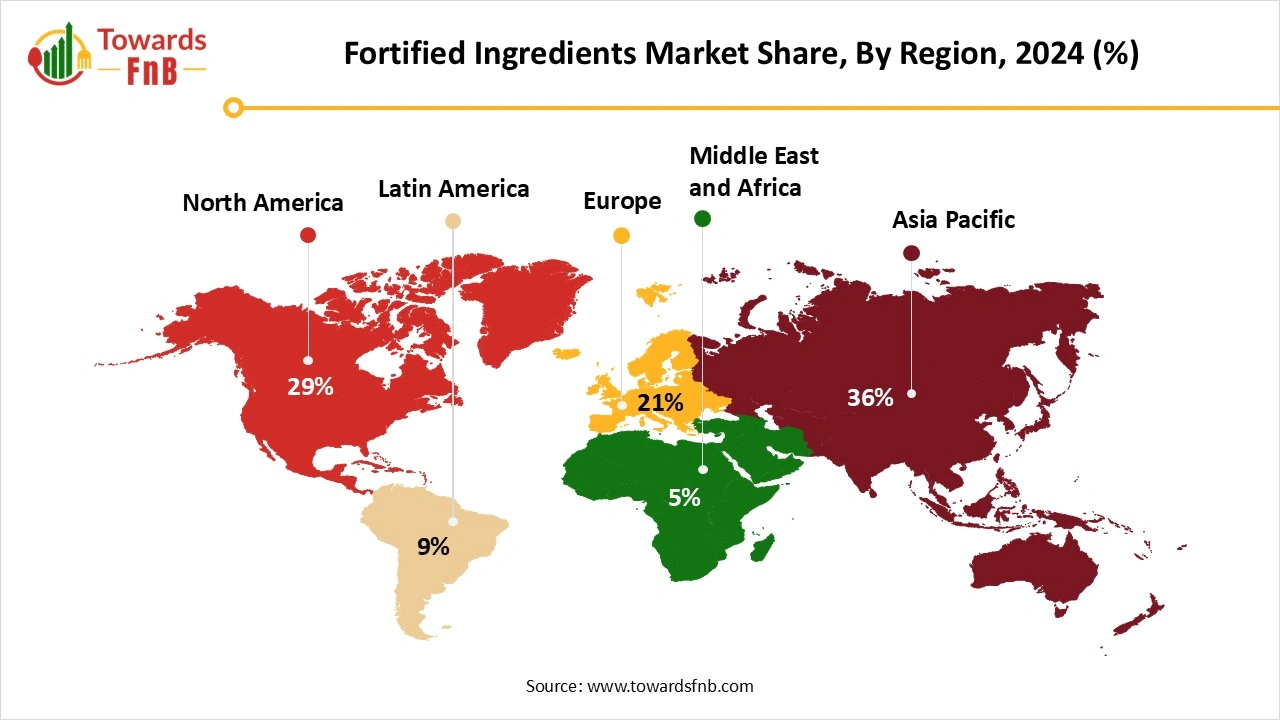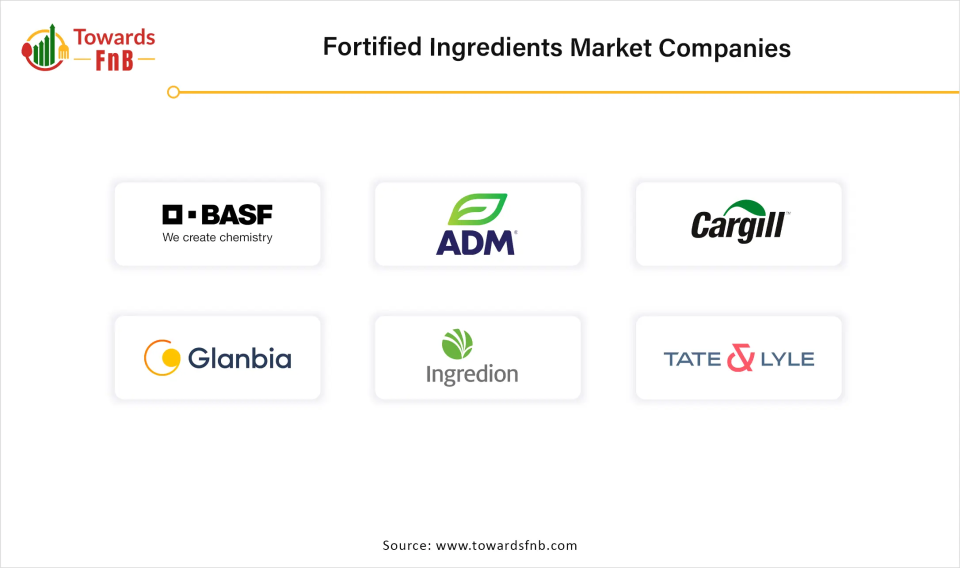December 2025
The global fortified ingredients market size was valued at USD 140.72 billion in 2024 and is expected to grow steadily from USD 148.60 billion in 2025 to reach nearly USD 242.66 billion by 2034, with a CAGR of 5.6% during the forecast period from 2025 to 2034. The increasing consumer demand for functional foods and beverages, micronutrient deficiencies and rising health awareness driving the market.

| Study Coverage | Details |
| Growth Rate from 2025 to 2034 | CAGR of 5.6% |
| Market Size in 2025 | USD 148.60 Billion |
| Market Size in 2026 | USD 156.92 Billion |
| Market Size by 2034 | USD 242.66 Billion |
| Largest Market | Asia pacific |
| Base Year | 2024 |
| Forecast Period | 2025 to 2034 |
| Regions Covered | North America, Europe, Asia-Pacific, Latin America, and Middle East & Africa |
The fortified ingredients market involves the development and commercialization of nutrients added to foods and beverages to enhance their nutritional value and address deficiencies. These ingredients include vitamins, minerals, amino acids, probiotics, prebiotics, and other bioactive compounds, commonly used in functional foods, dietary supplements, infant nutrition, and beverages.
Businesses are broadening their offerings to feature fortified snacks, drinks, and ready-to-eat meals, aimed at busy consumers who desire convenient and healthy choices. Collaborations among food producers, health service providers, and research organizations are also speeding up advancements in the fortified food sector. There are also chances in developing areas where malnutrition levels are severe; investing in education regarding fortified foods can result in greater market access. With changing consumer preferences, the ongoing emphasis on health and wellness is projected to greatly enhance the demand for food fortification ingredients over the next ten years.
Strict regulatory measures hinder market expansion The market for fortified ingredients faces rigorous regulatory requirements regarding health claims, safety, and labeling. Compliance with regulations can necessitate considerable time and costs, hindering market entry for newcomers. Fortified ingredients require substantial investment in product development and innovation, leading to an increase in the overall cost of the product. Moreover, the lack of high-quality laboratories impedes the regulation and oversight of products necessary to evaluate the quality of fortified foods, thereby limiting market expansion.
Asia Pacific Fortified Ingredients Market Trends
Asia Pacific dominated the fortified ingredients market in 2024. Increasing health consciousness, government-driven fortification initiatives, rising disposable incomes, and an active food and beverage sector are critical elements driving market growth. In emerging markets, the health-oriented dietary trends are growing quickly, driving the need for food enhancement. Variations in dietary intake among regions significantly influence the disparities in population health among nations. Several elements, such as growing rates of micronutrient shortages and chronic illnesses, new government enrichment initiatives, the expansion of the middle class in developing economies, the aging global population, and heightened interest in health and wellness, are expected to drive sales of fortified foods in the upcoming years, consequently raising the demand for functional food ingredients in the Asia Pacific.

India Fortified Ingredients Market Trends
The growing emphasis on health and wellness among consumers, heightened awareness of nutritional advantages, and rising demand for functional food items are primary elements driving this growth. At the same time, a 2024 survey conducted by FICCI revealed that 72% of urban Indian consumers favor food with enhanced health advantages, like those enriched with vitamins and minerals, boosting market expansion. The Indian government has been working to encourage food fortification to address malnutrition and deficiencies in micronutrients. The required fortification of essential foods like salt, milk, wheat flour, and cooking oils seeks to improve the nutritional intake for its 1.3 billion citizens. Programs such as the Food Fortification Resource Centre (FFRC) under FSSAI and policies promoting the distribution of fortified foods via the Public Distribution System (PDS), mid-day meal initiatives, and Integrated Child Development Services (ICDS) have bolstered market expansion.
Latin America & Sub-Saharan Africa Expect the Significant Growth During the Forecast Period.
The growth in the market is fueled by the development of the food and beverage processing industry in Brazil, Argentina, and Chile, where urbanization and increased disposable incomes are shaping consumer preferences for processed and ready-to-eat food items. Shoppers are increasingly conscious of the advantages of fortified foods and are proactively looking for items that can tackle health issues or nutritional gaps. Nutritional insecurity is a major issue confronting many developing nations globally, particularly in sub-Saharan Africa.
The United Nations World Food Programme estimates that more than 700 million individuals globally lacked sufficient food for a healthy, active lifestyle, with the highest percentage of these individuals situated in sub-Saharan Africa. It is estimated that over 2 billion individuals worldwide are experiencing micronutrient deficiencies, with three-quarters of this population located in sub-Saharan Africa. Sub-Saharan Africa represents over fifty percent of the worldwide cases of micronutrient malnutrition. Food fortification is recognized as one of the most efficient methods for addressing micronutrient deficiencies which boosting the demand for fortified ingredients during the forecast period.
Why Vitamins Segment Dominated the Fortified Ingredients Market in 2024?
Vitamins segment led the fortified ingredients market in 2024. In the last ten years, the vitamins industry has experienced a significant transformation fueled by consumer interest in comprehensive wellness and preventive health care. Increasing rates of chronic illnesses along with an aging worldwide population have led people to incorporate vitamins as essential components of their everyday health routines. In the meantime, progress in nutritional science has uncovered the physiological advantages of micronutrients, including vital B vitamins and fat-soluble vitamins that contribute to immune health and bone strength.
Probiotics & Omega Fatty Acids Segment is Observed to Grow at the Fastest Rate During the Forecast Period.
Increasing consumer awareness of gut health and its link to overall wellness has notably boosted the demand for probiotics. Probiotics, recognized for their role in balancing gut bacteria, are becoming more popular in preventing digestive issues like irritable bowel syndrome (IBS) and enhancing overall immune functionality. The omega-3 market keeps growing as consumers become more aware of the health advantages these essential fatty acids provide. Omega-3 fatty acids, such as eicosapentaenoic acid (EPA) and docosahexaenoic acid (DHA), are crucial for the health of the brain and heart. The need for omega-3 concentrates is increasing because of their accuracy in providing vital nutrients. They are commonly utilized in numerous applications, such as dietary supplements, functional foods, pharmaceuticals, and animal nutrition.
Which Form of the Fortified Ingredients Dominated the Fortified Ingredients Market in 2024?
Powder segment held the dominating share of the fortified ingredients market in 2024. The strong preference for powdered forms in mineral fortification is due to their adaptability and simplicity of blending into different food and beverage items. Powders provide improved stability, extended shelf life, and convenient storage, which are essential elements in the food processing sector. Moreover, powdered minerals can be easily incorporated into dry food blends, guaranteeing consistent distribution and preserving the product’s desired quality. The need for powder-based fortification is increasing because of its extensive use in functional foods, dietary supplements, and nutraceuticals.
Microencapsulated Formats Segment is Seen to Grow at a Notable Rate During the Predicted Timeframe.
The demand for improved ingredient stability and controlled release has driven substantial advancements in the food encapsulation field. Encapsulation methods are being used more widely in the food sector to safeguard delicate components like flavors, vitamins, probiotics, and enzymes from deterioration during processing and storage, while allowing for precise release during eating or digestion. Developments in microencapsulation technology are enabling the creation of microcapsules with enhanced characteristics.
Which Application of the Fortified Ingredients Dominated the Fortified Ingredients Market in 2024?
Functional foods segment dominated the market with the largest share in 2024. The need for functional foods enriched with vital nutrients rose because of their health advantages, like enhancing immunity. The rising need for bioengineered micronutrients, probiotic enhancements, and new functional ingredients is fueled by the expansion of plant-based and sustainable food options. Due to significant health advantages, core supplement users have been transitioning to fortified foods in recent years. The increase in demand for fortified foods is anticipated to boost market growth shortly.
Infant & Maternal Nutrition Segment is Expected to Grow at the Fastest Rate in the Market During the Forecast Period.
A key influencing factor is the growing awareness and emphasis on infant nutrition and health. As caregivers gain more knowledge about their infants' nutritional requirements, there is an increasing need for enhanced baby food items that deliver vital vitamins, minerals, and nutrients important for a child's growth. The World Health Organization states that around 295,000 maternal deaths happen annually, with malnutrition playing a major role. This concerning statistic highlights the crucial significance of proper maternal nutrition, promoting an increasing awareness of nutritional products tailored for this group.
Which End Use Industry Segment Dominated the Fortified Ingredients Market in 2024?
Food & beverage segment dominated the market in 2024. This growth was influenced by various factors such as the rising consumer inclination towards fortified and functional foods, heightened health awareness, and the convenience of fortified options. Shoppers are placing greater emphasis on health, wellness, and preventive nutrition, looking for beverages enhanced with vitamins, minerals, probiotics, and functional components. The appeal of plant-based and clean-label drinks is fostering innovation in natural fortification, as brands launch products that merge botanical extracts, superfoods, and adaptogens for enhanced health advantages.
Nutraceuticals & Clinical Nutrition Segment is Observed to Grow at the Fastest Rate During the Forecast Period.
This growth path is propelled by the increasing consumer appetite for health-promoting and functional food items, motivated by the rising prevalence of chronic diseases like obesity, diabetes, and heart conditions. A rising occurrence of malnutrition, digestive disorders, and metabolic diseases has driven the need for clinical nutrition among different middle-aged and elderly patient groups, along with those recovering from surgery and illness.
Which Distribution Channel Dominated the Fortified Ingredients Market in 2024?
Direct (B2B to food/pharma firms) segment held the dominating share of the market in 2024. These direct deals enable improved pricing, large-scale purchasing, and extended supply contracts. Top producers in this sector foster robust ties with multinational food corporations, guaranteeing steady demand. This channel guarantees product personalization, technical assistance, and prompt delivery, establishing it as the favored distribution method for key participants in the bakery, infant formula, dairy processing, and nutrition sectors.
Online B2B Platforms Segment is Seen to Grow at a Notable Rate During the Predicted Timeframe.
Expanding e-commerce platforms, rising consumer spending on fortified items, a growing trend for online shopping due to convenience and accessibility, a heightened preference for plant-based products, and an increasing rate of internet usage. With improved product labeling and transparent ingredient sourcing, consumer trust in fortified ingredients is increasing swiftly. E-commerce platforms have opened access to these products, allowing even smaller manufacturers to enter markets that were once unreachable. This change not only improves market access but also enables increased customization and adaptability in order processing, which is especially advantageous for B2B dealings.
Rasayanam
PepsiCo
Plenish

By Ingredient Type
By Form
By Application
By End-Use Industry
By Distribution Channel
By Regional
December 2025
December 2025
December 2025
December 2025